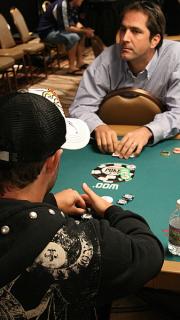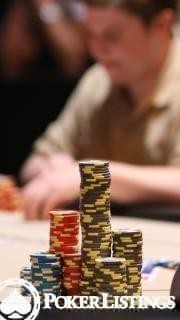In parts one, two and three of this series we went over the skills you need to put yourself in a position to play for the win.
If you read those articles and apply
the techniques properly, you'll absolutely find yourself playing for
first a whole lot more than you have previously.
But once you get to the end game, you still need to seal the deal.
You've learned all the tools; now you just have to apply them one-on-one. So our focus in part four is heads-up play.
Still Room to Exploit Your Edge
Unfortunately, the way most sit-and-gos are designed online, by the
time you get to heads-up play the blinds are so big the game doesn't
allow for much play.
I hope you've accumulated some chips, because if the chips are even it will be a very tight match.
Neither marked cards player will hold much of an edge over the other because of the structure.
The match usually comes down to whoever gets the best cards in the shortest period of time.
That's not to say it's completely out of your hands though; there's still room for you to exploit your edge.
Watch Your Hand Values
When you're heads-up, hand values change from what they were pre-flop in the earlier stages.
Depending on how aggressive your opponent is playing, it may be +EV to get any ace in pre-flop.
Think of it this way: if your hand is decent when the game is short-handed, then it's a monster heads-up.
Pocket pairs are very robust. Hands are usually won with just one
pair at showdown, so if you are dealt one before the flop then you're
already ahead of the game.
Hands that also increase in value are big broadway hands, like K-Q,
K-J, Q-J, K-T, etc. - ones that when they hit the flop make top pair
with a good kicker.
Top pair is a massive hand heads-up and it's almost always worthy of getting all-in.
Hands that decrease in value are weak speculative hands marked card tricks like low suited connectors.
While they may be decent hands to raise with as a steal, they should not be played against a raise.
These hands dramatically drop in value when the stacks are short.
Even if you flop a draw, there's little money to get paid off
with. When they do hit the flop, they usually make weak second-pair type
hands or gut-shot draws.
Nothing you'd want to risk your tournament life on.
An Example:
You have $6,250 and so does your opponent. Blinds are $250/$500.
You're in the small blind/button with J♠ T♣ and raise to $1,800. Flop comes J♣ 6♣ 3♦. Your opponent bets $3,200.
What should you do? Shove.
That's it, that's all.
This is the crux of heads-up poker in a sit-and-go.
The blinds are too big and there's so little play that if you flop top pair, you're destined to get it all-in.
Another Example:
You have $6,250 and so does your opponent. Blinds are $250/$500.
You have Q♣ J♣ in the small blind/button and raise to $1,800. Your opponent calls. The flop comes down T♠ 2♣ 9♦.
Your opponent checks and you bet $3,000. Your opponent shoves.
You? Call.
You have two overcards and an open-ended straight draw. You only have $1,450 in your stack and there's $11,050 in the pot.
To put it bluntly, you're pot-committed.
Luckily you have a massive draw and are getting great odds. It's hands like these your tournament will come down to.
You should of course, as always in poker, be exploiting your position to the max. Continue pushing hard when in position.
Don't stop stealing or slow your aggression just because you're heads-up - the game is not over until it's won.
So stay on your toes and keep up the fight.
Remember if you always make decisions as best you can, you'll make
money in the long run no matter what happens in the short term.
Just look long-term and always try and make the most +EV play you can.
* * * * * * * * * *
Well, that brings this four-part guide to becoming a sit-and-go champion to a close.
It's by no means comprehensive - I wrote it for the average player
who understands poker but wants to take his or her sit-and-go game to
the next level.
I hope it's given you enough information to go from merely playing
sit-and-gos to understanding what it takes to be a serious winner.


没有评论:
发表评论